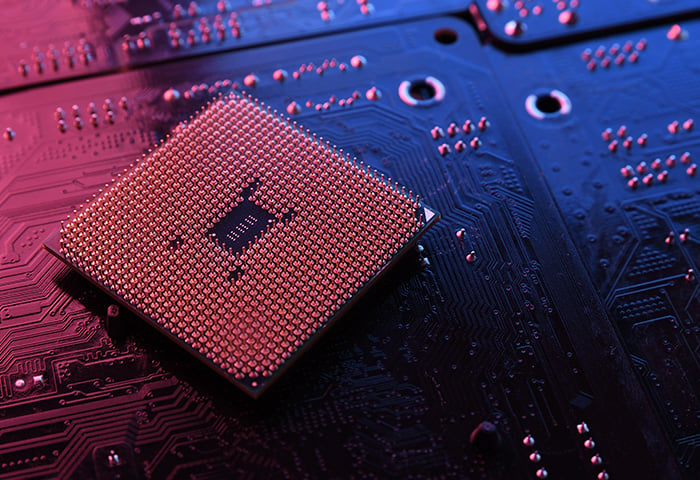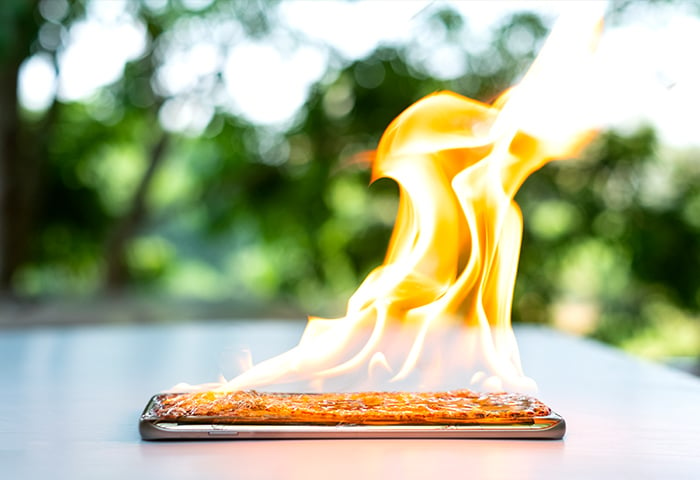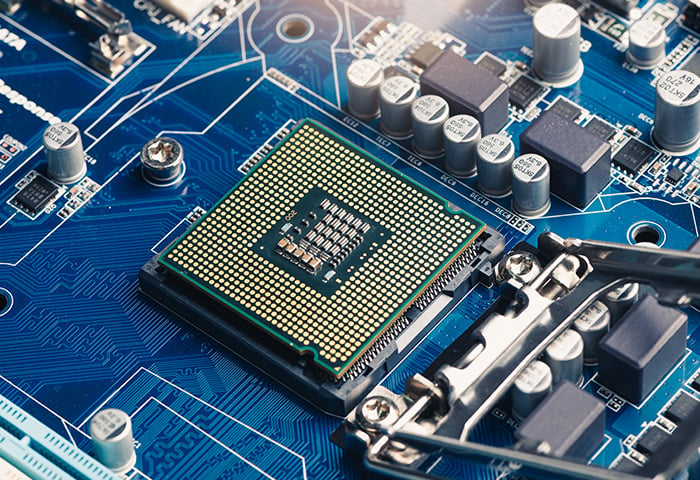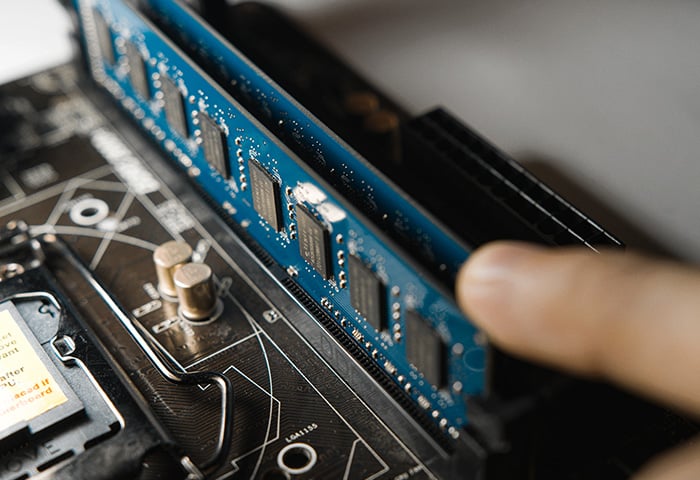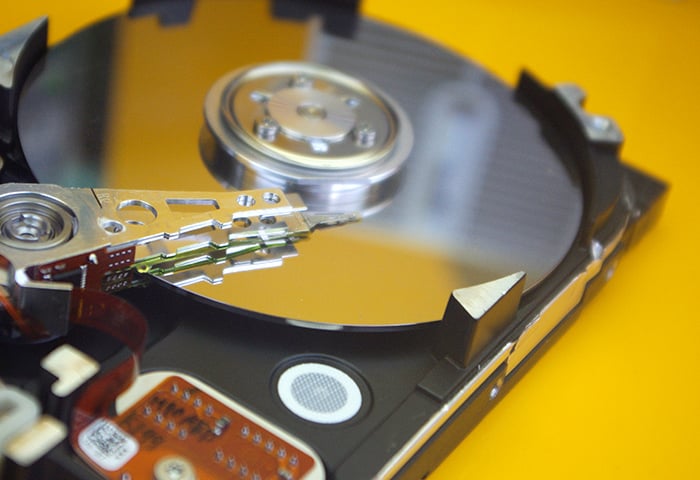Why does my phone get hot?
There are many reasons why phones get hot. Your phone temperature will increase whenever you’re using it for prolonged periods of time, running power-intensive apps, or using many apps simultaneously. A little warmth is common, but sustained high phone temperatures can be caused by bigger problems.
Phone overheating commonly happens in these situations:
/icon_01.svg) 1. Gaming for long periods of time
1. Gaming for long periods of time
The sheer breadth of available mobile games is one of the best reasons for buying a smartphone. But high-intensity gaming apps use your phone’s central processing cores in addition to its graphics processing unit (GPU), which can warm up your phone quickly.
/icon_02.svg) 2. Streaming content
2. Streaming content
Watching YouTube or Netflix for hours is another surefire way to overwork your phone’s processor. Streaming content or watching TV online means your phone has to load video data and keep the display active for a prolonged period of time.
/icon_03.svg) 3. Your settings aren’t optimal
3. Your settings aren’t optimal
If your screen brightness is always maxed out or you use animated wallpapers and widgets, try a static background and let your phone automatically adjust the screen brightness to match your environment. This will lighten the load on your phone’s CPU usage and keep your phone temperature down.
/icon_04.svg) 4. Outdated apps
4. Outdated apps
If an app has a bug or other problem, it may cause increased phone temps by overusing your device’s processor. Keep your apps and operating system updated, because updates often include important bug fixes. After you apply the update, your phone should perform better and overheat less frequently.
/icon_05.svg) 5. Software updates
5. Software updates
A phone may overheat during or right after an update. This might be because there was a bug in the OS that required fixing through the update, which can require increased power for a moment (but shouldn’t trigger a long-term overheating issue). Android phones have had issues with software updates in particular.
/06-using-navigation-apps.svg) 6. Using navigation apps
6. Using navigation apps
Using GPS-based navigation apps, like Google Maps or Waze, for extended periods can also put a strain on your phone. These apps constantly use both your phone’s GPS and data connection, which can cause your device to heat up as it processes real-time location data and displays directions.
/07-large-uploads-or-downloads.svg) 7. Large uploads or downloads
7. Large uploads or downloads
Transferring large files, whether downloading a film or synching your photo library to OneDrive, can heavily tax your phone’s processor and data connection. The continuous data flow and the need to handle large amounts of information can increase the temperature of your phone, especially if the task lasts for a long duration.
/icon_06.svg) 8. Environmental factors
8. Environmental factors
Leaving your phone outside in the sun or in your car on a hot day can cause it to overheat. This will also prevent the touchscreen from working properly and cause the battery to drain faster (excessive cold can have the same results). In addition to sun and heat exposure, water damage can also cause phone overheating.
/icon_07-1.svg) 9. Charging issues
9. Charging issues
It’s normal for a phone to get hot on the charger. But if your phone overheats when charging, it’s likely because your charging port is broken, the charging cable is worn out, or your battery is damaged.
To test these components, charge your phone with a different charging cable or a different charging port — or use a wireless charger. You can even try plugging your charger into a different outlet.
What causes your smartphone to overheat?
Phones often get hot from overuse or from having too many active apps. Your phone may also overheat due to malware, misbehaving software, or exposure to direct sunlight. It’s normal for phones to get a bit warm, but sustained heat can signal a deeper problem.
Why is my Android overheating?
Some common causes of phone overheating — such as malware, rogue apps, overactive background processes, and poorly designed third-party cases that cover phone vents — are more common on Android devices. If your Android device or battery regularly gets too hot, keep reading to learn how to turn down the heat.
Why is my iPhone overheating?
Because iPhones don’t get viruses and Apple doesn’t allow non-approved apps on the App Store, you might think iOS devices are less prone to all typical phone issues — like overheating phones. But that’s not necessarily true. If you’re wondering how to stop your iPhone from overheating so quickly, we’ll help you figure it out.
Is my battery faulty?
Often, your phone gets hot simply because the battery is working hard to process tasks — if you feel heat coming from the back of your phone, it’s likely your battery. Modern smartphones use powerful lithium-ion batteries that release heat as they generate electricity. That’s why a little heat is normal, especially when you use your phone for a long time.
But, in some instances, a faulty battery may be the main source of your overheating problems. Here are the main signs of a faulty phone battery to watch out for:
-
Repeated and persistent overheating even when you’re not using it intensively.
-
The battery draining quickly during normal usage.
-
Very slow charging, or not charging at all past a certain point.
-
Your phone suddenly powering off before the battery reaches the bottom.
How to cool down your phone
To cool down an overheating phone, first remove the case to release trapped heat. Then, turn on airplane mode for several minutes to disable battery-draining features like Bluetooth that may be running in the background. Next, move your phone to a cooler, shadier place — not the fridge or freezer.
Your cell phone works best at temperatures between 0 and 35 degrees Celsius (32 and 95 degrees Fahrenheit). Exposure to extreme temperatures outside of that range can impact your phone’s performance and hardware. So, instead of putting your overheating phone in the fridge, place it in front of a fan to cool down.
Here are some other things you can do to help your phone cool off:
-
Use less power: Typically, the reason why your phone is hot and losing battery is because you’ve been using it for a while. Take regular breaks to preserve your phone’s temperature and battery life.
-
Install junk-cleaning software: Junk files add extra work for your phone’s processor and battery. A dedicated maintenance app, like AVG Cleaner for Android, makes it easy to clean out unnecessary files, identify performance-draining apps, and remove bloatware to improve your phone’s performance and extend its battery life.
-
-
Reduce screen brightness: Keeping the screen at a lower brightness level will reduce the strain on your phone’s battery (and your eyes).
-
Restart your phone: Restarting your phone can help prevent overheating caused by minor software glitches.
-
Fully close apps when not using them: The more apps you have open at once, the harder your phone has to work. Close apps when you’re finished using them.
-
Switch to Battery Saver mode: Android's Battery Saver mode deactivates location services and background data, and limits power usage to extend battery life (and likely cool your phone down).
-
Prevent apps from running in the background: Background activity drains your battery and makes your phone work harder. Stop apps from using background data to give your phone a break.
-
Remove malware: Malicious software can quickly make your device overheat. Scan for and remove malware on your phone to improve its performance and reduce your phone temperature if you think your phone has been hacked.
-
See a professional: If you’ve tried all of these tips but your phone keeps getting hot, you might need to replace the battery. Take your phone to a reputable repair shop and see if they can help diagnose the issue or get you a new battery, if necessary.
How to stop your phone from overheating
It’s easy to prevent high phone temperatures. The basic phone-care habits listed here can help increase your phone’s lifespan and keep it from getting too hot. Here’s how to stop your phone from overheating.
/AVG-Fix-overheating-on-Android.png?width=550&height=984&name=AVG-Fix-overheating-on-Android.png)
1. Charge your phone correctly
Use a reliable charger from your phone’s manufacturer or another trusted brand, and charge your phone on a smooth, firm surface. Charging your phone on your couch or bed will prevent it from venting heat as it charges.
You may have heard that overnight charging is bad for your smartphone’s battery, but that’s a myth. Smartphones have protections in place to prevent overcharging, so it’s fine to charge your phone overnight — as long as you’re charging it on a hard surface and not underneath your pillow.
2. Update your apps
If you notice your phone heating up for no apparent reason, review any recently installed apps. Buggy apps can cause overheating, and updating your apps usually fixes this kind of problem.
If not, try uninstalling the app to see if it’s the reason your phone is overheating, and be sure to never install apps from a third-party app store. Also keep your phone’s operating system updated for optimal device performance and security.
3. Avoid direct sunlight
Whether you’re outside in the sun or charging your phone near a window, keep it out of direct sunlight. Keep it in the shade, leave it in your bag, or move it to where air is circulating.
4. Use an antivirus
Mobile spyware targeting Android and other types of malware can make your phone work overtime, causing it to get too hot. Remove mobile malware to stop your phone from overheating.
Mobile malware can also leak your sensitive information, steal your banking details, spy on your physical location, and drain your battery. And mobile ransomware can encrypt important files or even your entire device.
Install AVG AntiVirus for Android to protect your phone against the malware and rogue apps responsible for skyrocketing phone temperatures.
Where is the heat coming from?
When a phone gets too hot, the heat usually comes from the battery, processor, or screen. These components all generate heat: chemicals inside your phone’s battery create electricity, the processor transfers information at lightning speed, and your phone’s screen emits light.
So how can you pinpoint why your phone gets hot? You can make an educated guess about why your Android phone is heating up based on where the heat is coming from.
Back of the phone
If the back of your phone is getting hot, your battery may be overheating. Most modern mobile phones use lithium-ion (Li-ion) batteries that, despite their size, pack a powerful punch.
Lithium-ion batteries are generally safe, but malfunctions can occur. A hot battery may also need to be replaced, especially if it’s older — batteries tend to lose efficiency over time.
Bottom of the phone
Check if the bottom of the phone is hot to the touch when charging — if so, the problem might be with the charger. The most reliable charger is the one from your phone’s manufacturer. Third-party chargers are also fine — as long as they’re made by a reputable provider.
Above the battery, by the speaker, or the screen
If your phone’s excess heat isn’t coming from the battery or charger area, the temperature increase might be happening as a result of an overworked processor or from external factors, like direct sunlight.
Hot vs. warm: What’s the difference?
A phone’s internal temperature can be 36-43 degrees Celsius (96.8-109.4 degrees Fahrenheit) and still be considered normal. If your phone’s temperature is above 44° C, it’s too hot. Here’s how you can figure out your phone’s temperature.
On an Android phone, like a Samsung or LG model, the nifty AIDA64 app will give you a ton of information about your device’s hardware and software, including a phone temperature report. You can also check and monitor your CPU temperature if you’re worried your PC might be overheating as well.
Since some phone heat is normal, it’s better to determine overheating based on how often you notice your phone getting hot, or if the temperature is physically uncomfortable. Your phone should not be getting hot several times a day, or for no apparent reason.
/AVG-Phone-Temperatures.png?width=1320&name=AVG-Phone-Temperatures.png) Temperature ranges for safe to unsafe phone heat on Android.
Temperature ranges for safe to unsafe phone heat on Android.
Normal overheating vs. Samsung phone overheating
If you’ve had your phone for years, you may notice increasing phone temp issues over time. But there’s still a big difference between older Samsung and other Androids overheating, depending on how often they keep up with Android updates). The intense overheating in the Samsung Galaxy Note 7 caused battery explosions, causing the TSA sto stop allowing that particular Samsung Galaxy model on flights.
Though the Samsung Galaxy Note 7 is a particularly extreme case, we recommend reading reviews before you buy a new device to reduce your risk of dangerous phone overheating (or other problems). Samsung has attempted to mitigate phone overheating in the S7 and S8 models with a liquid cooling system.
When there’s a bigger problem
There are many simple explanations for why your cell phone is getting hot, but that doesn’t mean there’s always an easy fix. A chronically overheating phone can be a sign that it’s infected with malware, which severely affects your phone's security and overall performance.
Malware often consumes a ton of RAM and CPU power, which causes phone temperatures to rise. Android phones can even get ransomware, locking up files or entire devices. And that’s not the only type of malware floating around.
Android cryptominer malware
With the rise of Bitcoin, hackers have become very interested in cryptojacking, which entails hijacking devices to mine cryptocurrency. In 2017, a strain of trojan malware called Loapi infected Android phones by disguising itself as a fake antivirus app in the Google Play store.
Loapi malware was used by hackers to secretly mine Monero cryptocurrency. This maxed out the processor’s computing power and caused the device to overheat, making the phone’s battery bulge noticeably just two days after the initial infection.
A 2019 Android cryptominer spread automatically via SSH (a secure cryptographic network protocol) and ultimately affected victims in over 20 countries. There have also been a growing number of fake Android apps that infect devices with CoinHive, another type of Monero-mining malware. Hidden inside HTML files in an app’s assets folder, the mining script activates when the app is opened and continues running in the background.
Cool down your phone with AVG AntiVirus FREE
Removing malware from your phone is essential to your phone’s ongoing health and performance and keeping it cool. Concerningly, a number of the above-mentioned malicious apps have been found in the Google Play store. Paying attention to phone overheating can help you identify a malware infection caused by a seemingly harmless download.
Since Android phones are more vulnerable to malware than iPhones, a trusted mobile antivirus like our free AVG AntiVirus for Android is a must. It’s the best way to prevent malware from harming your device, and it’ll protect you against unsafe apps, unwanted callers, theft, and much more. Get AVG AntiVirus today.
FAQs
Why is my phone hot when charging?
Charging your phone heats it up because the phone’s charging circuit generates heat while the battery is being refilled. Charging a phone on a couch or bed will cause it to heat up even more, because it’s less able to vent heat. When charging your phone, place it on a smooth, firm surface and don’t continue to use it.
If your phone gets too hot or overheats while charging, it’s likely because your charging port is broken, the charging cable is worn out, or your battery is damaged. In that case, take steps to prevent your Android or iPhone overheating. But remember, it’s a smartphone myth that charging your phone shouldn’t cause it to heat up at all.
Is it okay to put a phone in the fridge or a freezer?
It’s never a good idea to put phones or other sensitive electronic devices in a fridge or freezer — this can cause long term damage to your device. Instead, use battery saver mode, remove junk files, and restrict background data use to help regulate your phone’s temperature. If you’re still having trouble cooling your phone down, try restarting it. Ongoing problems could be a sign that you need to remove malware from your phone.
Is there an app to cool down my phone?
Mobile apps such as AVG Cleaner for Android can help fix causes of overheating by deleting junk files and data-hogging apps that are draining your phone’s resources. Some types of malware can hijack your phone’s resources for nefarious processes, so using antivirus for Android and iOS mobile security can also bring performance benefits.
How to check phone temperature
You can check how hot your phone is by using third-party apps such as AIDA64, which displays temperature and other status information of internal components for Android and iOS devices. Other, Android-specific apps, such as Cooling Master and CPU-Z, are designed to detect and prevent overheating by managing processor workload and shutting down problematic apps.
Can overheating damage your phone?
A phone that persistently overheats can cause long-term damage to your battery, throttle performance, and reduce the overall health and longevity of your device. If your phone is left out in the sun or exposed to high temperatures for extended periods of time, that can also cause long-term damage.

/AVG-Fix-overheating-on-Android.png?width=550&height=984&name=AVG-Fix-overheating-on-Android.png)
/AVG-Phone-Temperatures.png?width=1320&name=AVG-Phone-Temperatures.png) Temperature ranges for safe to unsafe phone heat on Android.
Temperature ranges for safe to unsafe phone heat on Android.

